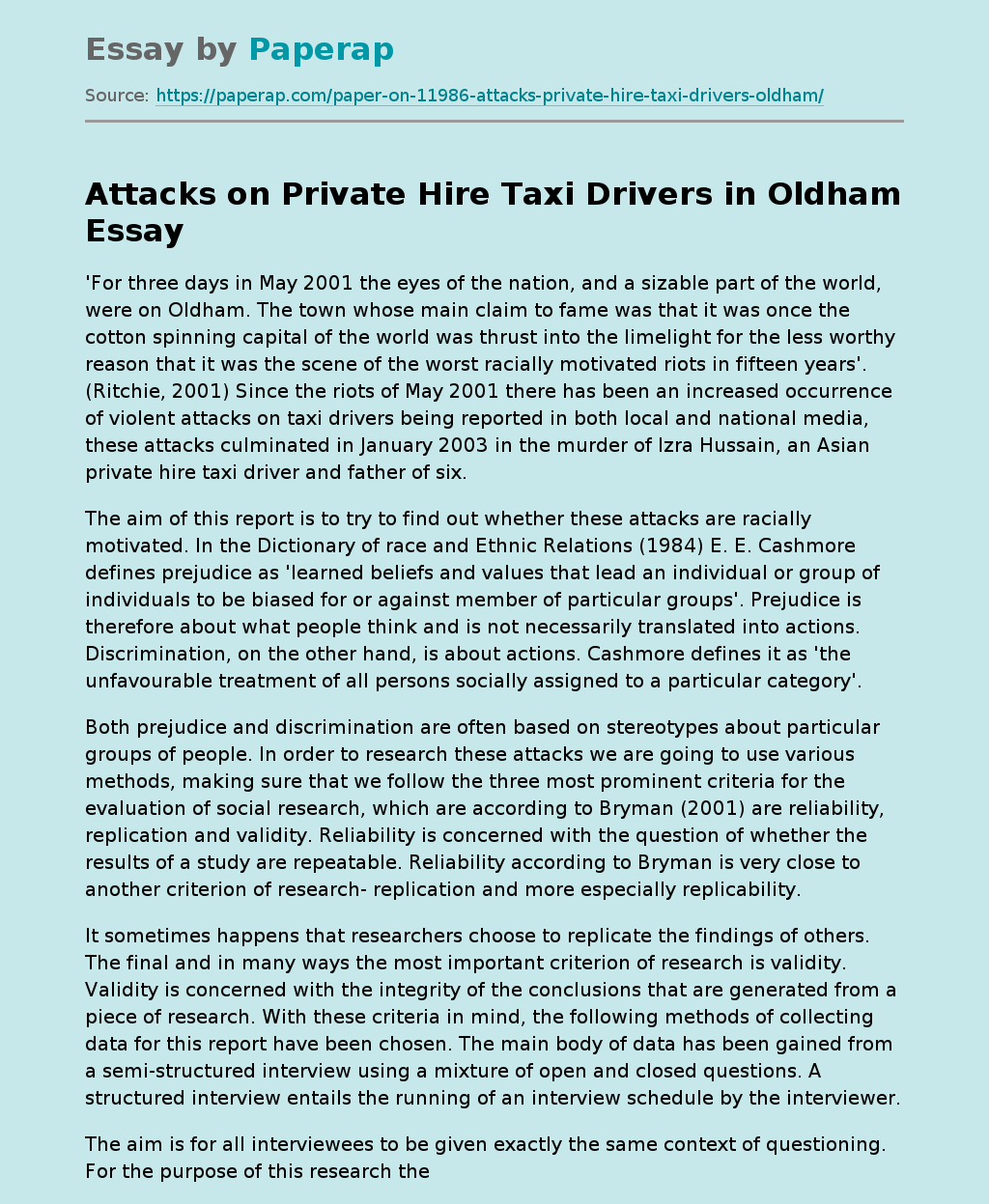Attacks on Private Hire Taxi Drivers in Oldham
For three days in May 2001 the eyes of the nation, and a sizable part of the world, were on Oldham. The town whose main claim to fame was that it was once the cotton spinning capital of the world was thrust into the limelight for the less worthy reason that it was the scene of the worst racially motivated riots in fifteen years. (Ritchie, 2001) Since the riots of May 2001 there has been an increased occurrence of violent attacks on taxi drivers being reported in both local and national media, these attacks culminated in January 2003 in the murder of Izra Hussain, an Asian private hire taxi driver and father of six.
The aim of this report is to try to find out whether these attacks are racially motivated. In the Dictionary of race and Ethnic Relations (1984) E. E. Cashmore defines prejudice as ‘learned beliefs and values that lead an individual or group of individuals to be biased for or against member of particular groups’.
Prejudice is therefore about what people think and is not necessarily translated into actions. Discrimination, on the other hand, is about actions. Cashmore defines it as ‘the unfavourable treatment of all persons socially assigned to a particular category’.
Both prejudice and discrimination are often based on stereotypes about particular groups of people. In order to research these attacks we are going to use various methods, making sure that we follow the three most prominent criteria for the evaluation of social research, which are according to Bryman (2001) are reliability, replication and validity.
Reliability is concerned with the question of whether the results of a study are repeatable. Reliability according to Bryman is very close to another criterion of research- replication and more especially replicability.
It sometimes happens that researchers choose to replicate the findings of others. The final and in many ways the most important criterion of research is validity. Validity is concerned with the integrity of the conclusions that are generated from a piece of research. With these criteria in mind, the following methods of collecting data for this report have been chosen. The main body of data has been gained from a semi-structured interview using a mixture of open and closed questions. A structured interview entails the running of an interview schedule by the interviewer.
The aim is for all interviewees to be given exactly the same context of questioning. For the purpose of this research the interviews were conducted in person by visiting the interviewees in their work situation. The sample for this research was taken from private hire taxi drivers, figures from Oldham Metro Council’s licensing Department (2003) state that there are approx 800 drivers working and that they are split roughly 60% Asian and 40% UK/White. Given these figures, 20 respondents, 12 Asian and 8 UK/White were chosen.
This meant going to various private hire taxi offices in the Oldham area. In a personal interview, the interviewer may respond to signs, such as puzzlement or unease, by restating the question or attempting to clarify the meaning of the question. This may entail prompting, when an interviewer suggests a possible answer to a question to the respondent. Bryman (2001) states that prospective respondents have to be provided with a credible justification for the research in which they are being asked to participate and for giving up their valuable time.
The results from the interview were noted by writing down the respondent’s replies. To back up our main body of research, a quantitative content analysis of local newspaper and taxi trade magazines. In analysis we sought to quantify the contents in terms of predetermined categories. In this case we looked for individual stories, which portrayed physical assaults on taxi drivers, by counting individual stories and then analysing the nature of assault and the types of perpetrators involved. The local newspaper archive was used and sources from the last 2 years were analysed.
The analysis of the taxi trade magazine, which was carried out on-line, was used to see if these attacks took place nationally. Bryman (2002) states that content analysis is a very transparent research method; it can allow a certain amount of longitudinal analysis with relative ease. Pawson (1995) argues that formal content analysis is not without its problems. Simply counting the number of items tells you nothing about their significance, and the meanings of the text or images being studied can only be implied.
Our research found that out of 20 respondents, 12 where of Asian, Pakistani or Bangladeshi descent, and 8 described themselves as of White UK descent. The age of the respondents was between 25 and 65. Of the 20 respondents 17 were married, 2 were co-habiting and one was single. It should be noted that all of the Asian respondents were married and all had children. All the drivers interviewed described themselves as self-employed private hire taxi drivers.
They worked on average 60 hours a week; this was usually split between days and evenings. The evening work was mostly on Friday and Saturday. Shifts of 12 hours were not unusual at busy times. Oldham is a mixed urban and rural town on the edge of the West Pennines, most of the private hire taxi offices (22 in all) are situated in the town centre, but the drivers cover the whole borough. When asked about attacks on private hire driver 19 out of the twenty respondents reported that they had suffered some form of attack or abuse.
Attacks on Private Hire Taxi Drivers in Oldham. (2018, Jan 04). Retrieved from https://paperap.com/paper-on-11986-attacks-private-hire-taxi-drivers-oldham/

